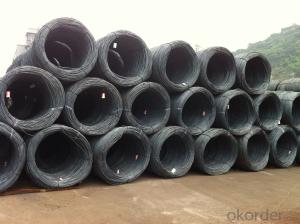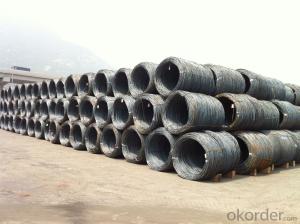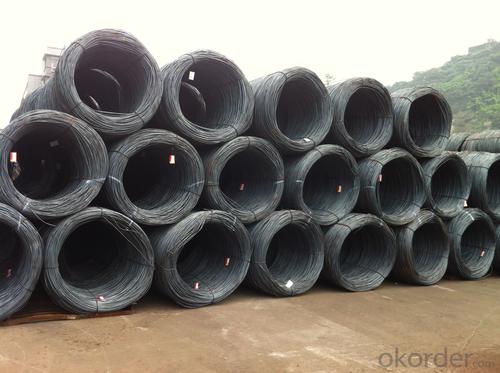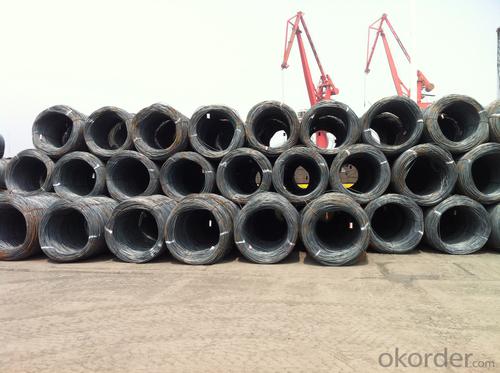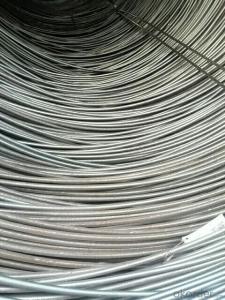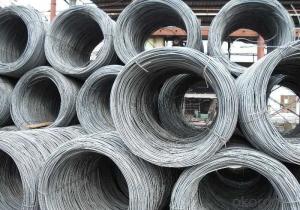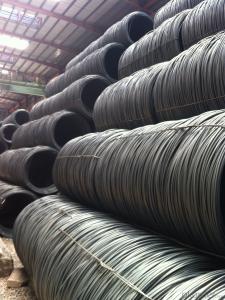Hot Rolled Steel Wire rods in Grade SAE1006-1018
- Loading Port:
- Tianjin
- Payment Terms:
- TT OR LC
- Min Order Qty:
- 25 m.t
- Supply Capability:
- 20000 m.t/month
OKorder Service Pledge
OKorder Financial Service
You Might Also Like
OKorder is offering Carbon Steel Wire Rod at great prices with worldwide shipping. Our supplier is a world-class manufacturer of steel, with our products utilized the world over. OKorder annually supplies products to European, North American and Asian markets. We provide quotations within 24 hours of receiving an inquiry and guarantee competitive prices.
Product Applications:
Carbon Steel Wire Rod are ideal for structural applications and are widely used in the construction of buildings and bridges, and the manufacturing, petrochemical, and transportation industries.After hot-rolled the products shaped into coil and delivery as finished product, including round, square, rectangular, hexagonal and so on. Since most of the products are round, it is generally called wire rod. Carbon steel wire rod is widely used in construction and manufacturing. Carbon steel wire rod is mainly used for reinforcement of reinforced concrete and welded structure or reprocessed (roberts , nail, etc.) materials, especially used to produce wire drawing, welding electrode, nails, spring, electronic, precise machinery parts and so on.
Product Advantages:
OKorder's Carbon Steel Wire Rod are durable, strong, and resist corrosion.
Main Product Features:
· Premium quality
· Prompt delivery & seaworthy packing (30 days after receiving deposit)
· Corrosion resistance
· Can be recycled and reused
· Mill test certification
· Professional Service
· Competitive pricing
Product Specifications:
Chemical Composition:
Please kindly find our chemistry of our material based on SAE1006/SAE1008 as below for your information
Grade | Chemical Composition (%) | |||||
C | Mn | S | P | Si | B | |
SAE1006 | 0.03~O.07 | 0.32max | 0.045max | 0.040max | 0.30max | 0.0008min |
Mechanical properties | ||||||
Yield strength(N/mm2) | Tensile strength(N/mm2) | Elongation (%) | ||||
250-280 | 350-380 | ≥32 | ||||
Grade | Chemical Composition (%) | |||||
C | Mn | S | P | Si | B | |
SAE1008 | 0.10max | 0.3~0.50 | 0.050max | 0.040 max | 0.15max | 0.0008 min |
Mechanical properties | ||||||
Yield strength(N/mm2) | Tensile strength(N/mm2) | Elongation (%) | ||||
≥195 | 315-430 | ≥30 | ||||
FAQ:
Q1: Why buy Materials & Equipment from OKorder.com?
A1: All products offered byOKorder.com are carefully selected from China's most reliable manufacturing enterprises. Through its ISO certifications, OKorder.com adheres to the highest standards and a commitment to supply chain safety and customer satisfaction.
Q2: What's your shipment type ?
A2: Usually we ship the goods by bulk vessel,if you want load them by container vessels,we can arrange as well .
Q3:What's your payment terms ?
A3:Mostly,we collect the money by T/T and LC at sight . We also accept time LC at 90/120 days sight.
Images:
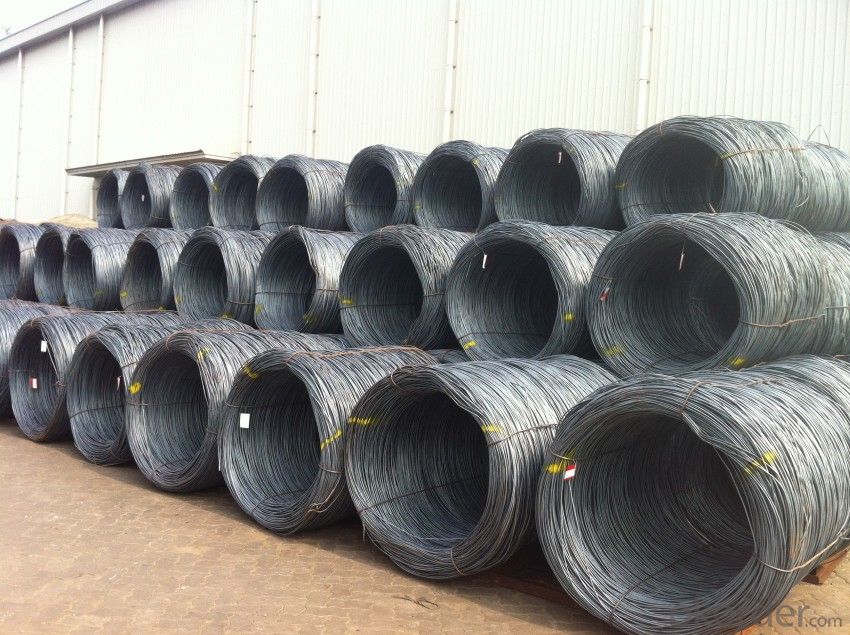

- Q: How is the fatigue strength of steel wire rod determined?
- The fatigue strength of steel wire rod is established by conducting a series of tests that entail subjecting the material to repetitive cycles of loading and unloading until it fails. This procedure, known as fatigue testing, aids in determining the endurance limit or fatigue strength of the wire rod. Throughout the process of fatigue testing, a sample of the steel wire rod is prepared in accordance with specific standards and guidelines. Typically, the sample takes the form of a specimen with standardized dimensions and shape. The preparation of the sample entails meticulously machining the wire rod to eliminate any surface imperfections or irregularities that could impact the test results. The subsequent step involves subjecting the sample to cyclic loading, wherein the wire rod is repeatedly exposed to a fluctuating load. This can be achieved using specialized testing machines that apply the load in a controlled manner. The load applied during the testing process may either be of constant amplitude or variable amplitude, depending on the specific requirements of the test. The sample is usually loaded with a range of stress amplitudes, commencing from a relatively low value and progressively increasing until failure occurs. The number of cycles until failure is recorded for each stress level, and this data is employed to construct an S-N curve, also known as a fatigue curve. The S-N curve depicts the correlation between the applied stress amplitude and the number of cycles until failure. Through analysis of the S-N curve, engineers can determine the fatigue strength of the steel wire rod. Fatigue strength is generally defined as the stress amplitude at which the material can endure an infinite number of cycles without experiencing failure. This is commonly referred to as the endurance limit. In addition to fatigue testing, other factors such as material composition, surface finish, and environmental conditions can also impact the fatigue strength of steel wire rod. Hence, it is crucial to consider these factors when assessing the fatigue strength of the wire rod for specific applications.
- Q: What are the common production processes for nobelium-coated steel wire rod?
- The common production processes for nobelium-coated steel wire rod include wire drawing, cleaning, coating deposition, and annealing.
- Q: How does the quality of steel wire rod affect its performance?
- The quality of steel wire rod directly impacts its performance. High-quality steel wire rod possesses superior strength, durability, and resistance to deformation and breakage. It ensures efficient and reliable performance in various applications, such as reinforcing structures, manufacturing cables, wires, and springs. In contrast, low-quality wire rod may lack necessary strength and integrity, leading to compromised performance, increased risk of failure, and reduced overall effectiveness in its intended use.
- Q: How is steel wire rod used in the production of wire mesh for industrial sieving?
- Wire mesh for industrial sieving relies heavily on steel wire rod, which plays a vital role in its production. This mesh finds widespread application in industries like mining, construction, and agriculture, where it is used to separate and classify materials based on their size and shape. To create wire mesh, the steel wire rod undergoes a series of manufacturing steps, transforming it into a suitable form. The rod is typically subjected to wire drawing, a process that involves passing it through a series of dies to reduce its diameter and increase its length. As a result, the wire becomes thin and elongated. Once the wire rod has been drawn, it is either woven or welded together to form the wire mesh. Weaving involves interlacing the wires in a crisscross pattern, creating a strong and durable structure. Conversely, welding involves fusing the wires at their intersections using heat or pressure, resulting in a solid and stable mesh. The choice between weaving and welding depends on specific requirements. Weaving is ideal for producing wire mesh with smaller openings and finer mesh sizes, while welding is preferable for larger openings and heavier wire diameters. The steel wire rod used in wire mesh production offers various advantages for industrial sieving. Firstly, steel is a highly durable and robust material, capable of withstanding harsh environments and heavy loads. This ensures that the wire mesh remains structurally intact even when subjected to constant material impact during the sieving process. Additionally, steel wire rod provides excellent tensile strength, enabling the wire mesh to maintain its shape and resist deformation under tension. This is particularly important for high-pressure sieving applications or situations where the mesh needs to be tightly stretched over a frame. Furthermore, steel wire rod can be coated or treated to enhance its resistance to corrosion, abrasion, and other forms of wear and tear. This prolongs the lifespan of the wire mesh, making it suitable for long-term industrial use. In conclusion, steel wire rod is a crucial component in the production of wire mesh used for industrial sieving. Its versatility, durability, and strength make it an ideal raw material for creating wire mesh capable of withstanding rigorous sieving applications in various industries.
- Q: How is steel wire rod used in the production of wire strands for electrical transmission lines?
- Steel wire rod is used in the production of wire strands for electrical transmission lines by being stretched, twisted, and coated with protective layers to form strong and durable wire strands. These wire strands are then bundled together to create the conductive core of the transmission line, which carries electricity over long distances with minimal energy loss.
- Q: How is steel wire rod used in the manufacturing of electrical wires?
- Steel wire rod is used in the manufacturing of electrical wires as the primary raw material. It is typically drawn through a series of dies to reduce its diameter and increase its length, resulting in a thin and flexible wire. This wire is then used to conduct electricity in various electrical applications, including power transmission, telecommunications, and electrical appliances.
- Q: How is steel wire rod used in the production of wire displays?
- Steel wire rod is used in the production of wire displays as it serves as the foundation material for creating the wire frames and structures that make up the displays. The wire rod is first processed and shaped into the desired dimensions and then formed into different shapes and configurations to create the structures that hold and showcase products in wire displays.
- Q: How is steel wire rod processed into different wire products?
- Steel wire rod is processed into different wire products through a series of manufacturing processes. The first step involves the uncoiling of the steel wire rod, which is typically done using a machine called a pay-off reel. Once uncoiled, the wire rod is then cleaned to remove any dirt or rust using a pickling solution or shot blasting. After cleaning, the wire rod is passed through a series of rollers to reduce its diameter and increase its length. This process is called drawing, and it is usually done in multiple stages to achieve the desired thickness and strength. The wire rod is pulled through a die in each stage, gradually reducing its diameter. Once the wire has been drawn to the desired size, it is then annealed to relieve any internal stresses and improve its ductility. Annealing involves heating the wire to a specific temperature and then slowly cooling it down. This process makes the wire more flexible and easier to work with. Next, the wire may undergo additional processes such as galvanizing or coating. Galvanization involves dipping the wire in a bath of molten zinc to provide it with a protective layer against corrosion. Coating can be done using materials such as PVC or nylon to provide the wire with additional properties, such as insulation or increased strength. Finally, the wire is spooled onto reels or packaged into coils for transportation and storage. Depending on the specific wire product being manufactured, additional processes such as cutting, bending, or welding may be performed to shape the wire into its final form. Overall, the process of transforming steel wire rod into different wire products involves a combination of drawing, cleaning, annealing, and additional treatments to achieve the desired properties and dimensions. This complex process ensures that the wire products meet the required standards and are suitable for various applications in industries such as construction, automotive, and manufacturing.
- Q: What are the common traceability requirements for steel wire rod?
- Some common traceability requirements for steel wire rod include the need to track and document the origin of the raw materials used, the manufacturing processes involved, and the final destination or customer for each batch of wire rod produced. Additionally, traceability requirements may also involve keeping records of quality testing and inspection results, as well as maintaining a comprehensive documentation system to ensure transparency and accountability throughout the supply chain.
- Q: What is the maximum allowable deviation in diameter for steel wire rod?
- The maximum allowable deviation in diameter for steel wire rod depends on the specific standards and specifications set by different industries and applications. However, in general, the maximum allowable deviation in diameter for steel wire rod is typically specified as a percentage or a specific tolerance range. For example, in the steel industry, the maximum allowable deviation in diameter for steel wire rod can range from +/- 0.010 inches to +/- 0.020 inches, depending on the specific grade and intended use of the wire rod. This means that the diameter of the wire rod can be slightly larger or smaller than its specified value within this tolerance range. It is important to note that these tolerances may vary depending on the specific industry requirements and the intended application of the steel wire rod. Therefore, it is essential to consult the relevant standards, specifications, and guidelines provided by the industry or application to determine the maximum allowable deviation in diameter for steel wire rod in a particular context.
Send your message to us
Hot Rolled Steel Wire rods in Grade SAE1006-1018
- Loading Port:
- Tianjin
- Payment Terms:
- TT OR LC
- Min Order Qty:
- 25 m.t
- Supply Capability:
- 20000 m.t/month
OKorder Service Pledge
OKorder Financial Service
Similar products
Hot products
Hot Searches
Related keywords
